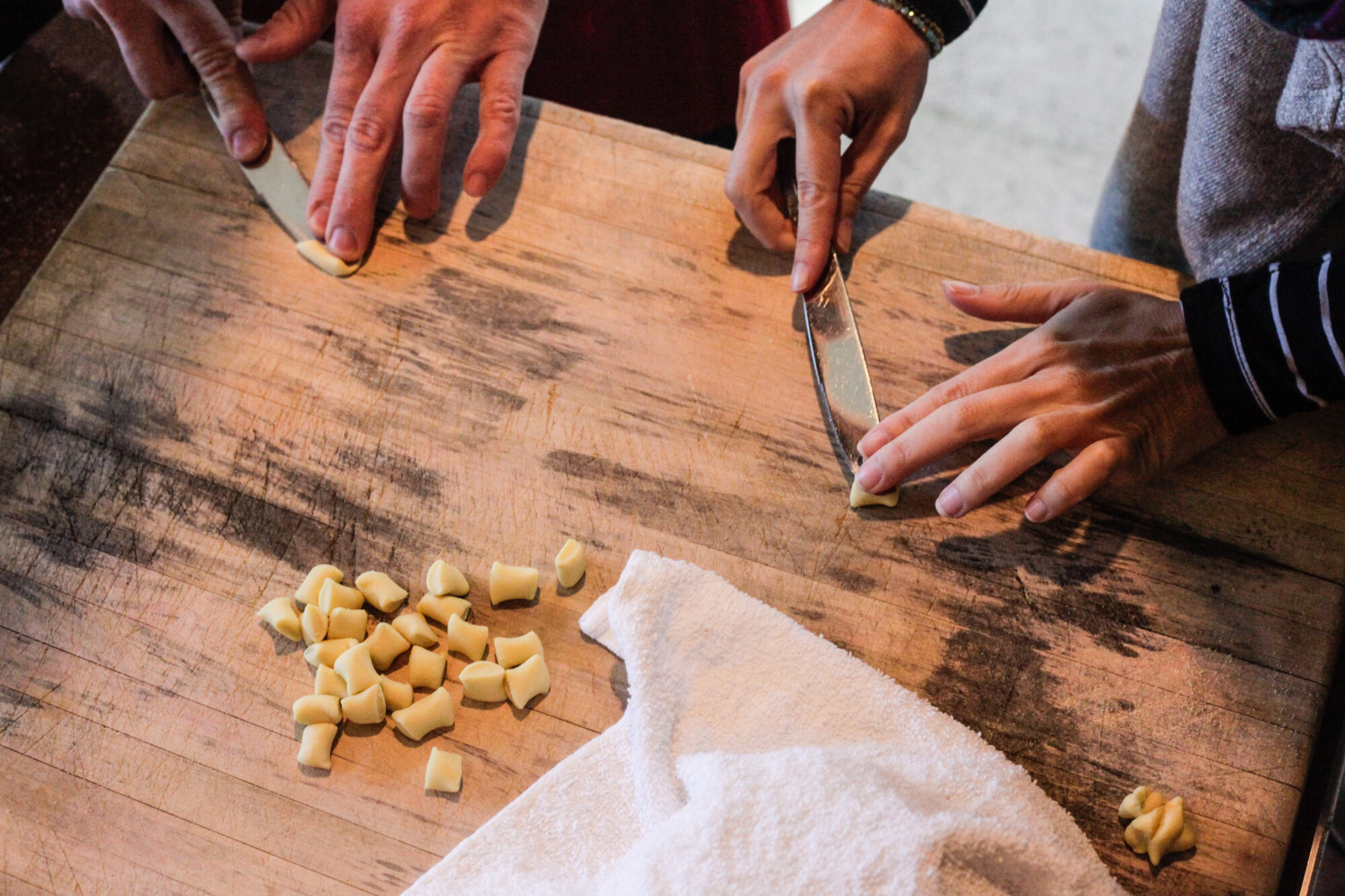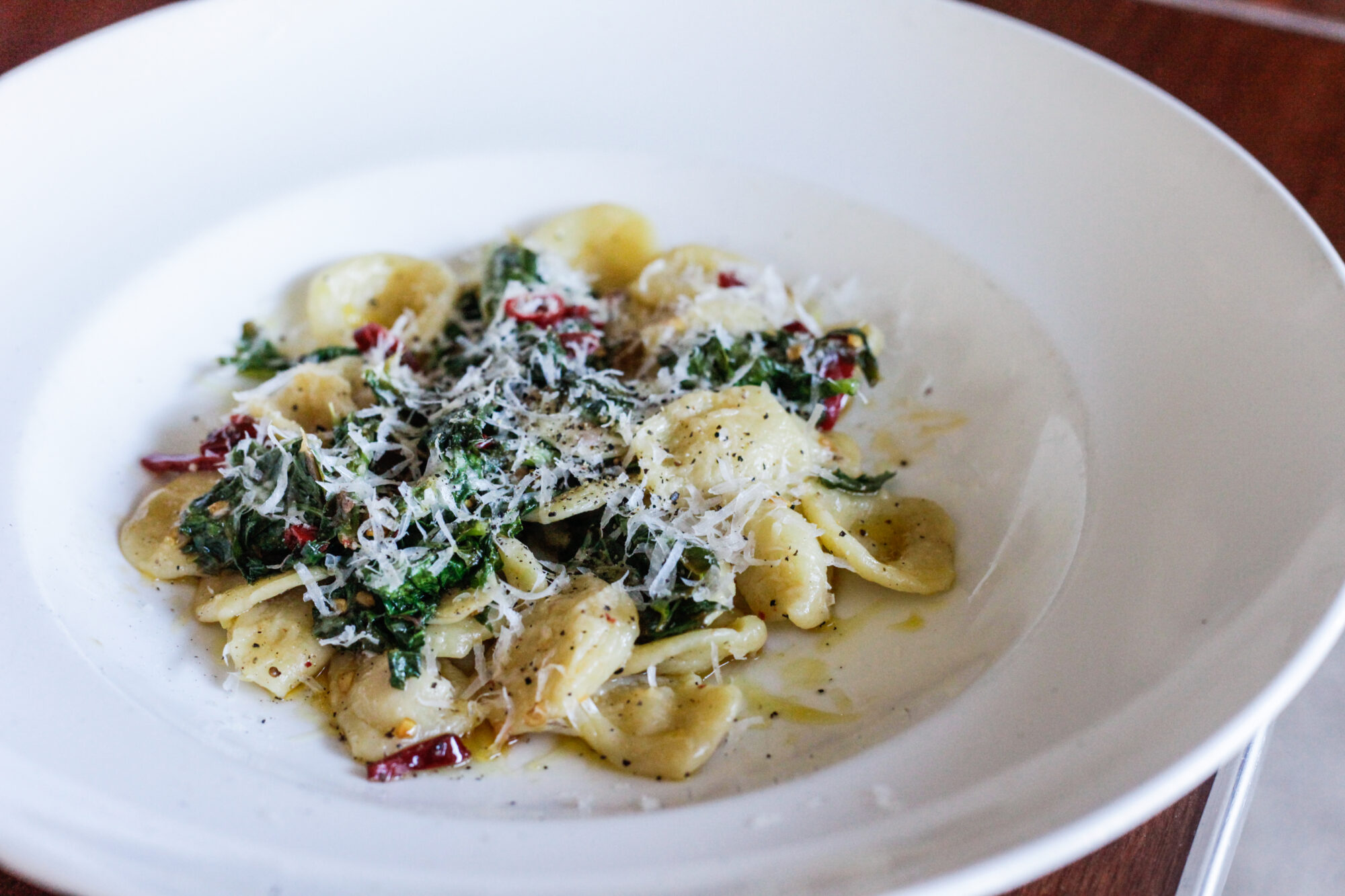By Andrea Frances
Under the helm of Executive Chef Justin Rupp, Olive & June became one of a small stock of kitchens in Austin to craft pasta by hand daily. The effort has earned Olive & June sustained praise over the years. Rupp’s pasta program features a six-offering pasta primi menu – a delicious selection of pastas ranging from ravioli to classic spaghetti and toothsome bucatini are paired with classic and seasonal components – in addition to a special primi for the weekly Sunday Supper.
What makes them special? Homemade pasta. Why? Because handmade is infinitely greater than any boxed pasta you purchase.
There’s a standing debate over homemade pasta. Is it worth all the trouble? Is there really any difference? How many ingrédients and tools do you actually need to make it? How does one even start? Let’s talk about this…
“Worth the trouble?” Absolutely. Is it worth the trouble if you have an infant in your charge, a job and only 30 minutes to make dinner? No, it isn’t worth your trouble; send this to a friend, it’s worth theirs (and you’ll benefit, God bless new moms).
“Is there really a difference?” The difference is real. Boxed pastas are glassy, silky smooth and generally lacking egg unless specified as an egg noodle. This texture does not hold onto sauce and it just isn’t as beautiful. Ergo, if you happen to like pasta evenly and generously coated with sauce, handmade pasta what you want. Generally speaking, handmade pasta is also more toothsome, slightly more chewy than boxed pasta. Two points for scratch pasta.
“It’s so much work, I am scared to try.” It seems like a lot of work, possibly even intimidating, but you can make basic pasta with flour, water and a couple of tools. What you need depends upon your available storage space, your level of expendable cash and the frequency with which you will make pasta at home. Best bets for a home cook who plans to make fresh pasta semi-routinely are: a good stand pasta maker (plus an attachment to cut pasta shapes); a chitarra (which makes two types of long noodles – typically fettuccine and traditional spaghetti); a rolling pin; a bench knife; and, a large [wood] cutting board. You can use a stand mixer or your own elbow grease to knead the dough. An extruder, and attachments, can perform the entire act of making pasta from kneading the dough to extruding short pasta rigatoni. They cost a pretty penny, ranging from $1,100 to $2,400, but render pasta-making significantly less aggressive.
“But, Where do I start?” You start where one always starts: the beginning. Chef Rupp walks you through the simple process:
- Choose and mix ingredients.
- Knead the dough and rest.
- Roll and shape pasta.
- Cook.
- Consume.
I. Ingredients
For longer pastas, Chef Rupp uses a flour blend (part semolina – a coarse, sand-like flour, part durum – a finely ground flour), water and egg to create a mixture that’s coarse, but not overly so. Egg yolk lends a beautiful yellow hue, chewy texture and structure. Simply make a mound of flour with a well in the center, crack egg, add water and mix. Use a fork or your fingertips to gradually start pushing flour into the pool of egg. Continue to add flour, a little at a time, until you no longer need to use the fork. The dough will be wet and sticky, but should be one mass. The end yield is pebbly, slightly crumbly; when squeezed in your palm it should become solid.
“I use lower percent hydration level (water to flour) for an egg pasta that will become fettuccine/linguine,” says Rupp. “Hand rolled pastas, like ravioli and orecchiette have a higher hydration value. You can always add water, but you can’t ever take it away. Start with low hydration values and add more slowly – by the half-ounce. Chemistry is affected by season, temperature, size of egg and humidity levels, so the exact hydration level varies. In the winter, we add more water because the air is colder and drier.”
II. Kneading
If kneading with your hands or a stand mixer, knead with force for about 8 to 10 minutes and let ‘hydrate’ (i.e. the resting time water needs to soak into the starch and activate the gluten) for about 30 minutes. Texture should be elastic, if you push down it should pop up. If using an extruder, allow it to warm up prior to use. Knead per instructions then allow it to rest. Once your dough is balled and flattened into a thick disc, cover it with a barely damp cloth or plastic wrap to retain moisture and prevent cracking.
III. Rolling and Shaping
Using a bench knife, cut a section of dough from the disc. Set pasta maker to the widest setting, sprinkle dough with a small amount of flour and roll through manually. Then adjust to the second widest setting and roll the dough through a second time. Roll a third time, allowing a space of two fingers on either side of the dough. Continue until you have a workable sheet of pasta.
“You are rolling thinner and thinner iterations of the dough. For pasta noodles, you want to keep the dough slightly thicker – three times through should be sufficient in most long noodle occasions. For dough like ravioli dough, you want to roll until it’s at it’s thinnest without tearing because you need to put these two together and you need higher elasticity.”
“Once you have sheets, you shape your noodles. Depending on your equipment and desired shape, you have a couple of options. We use a chitarra to make our long pasta, the extruder to make short pasta and our hands to make pastas like orecchiette.”
Using chitarra, use a ruler to cut the sheets slightly smaller than the chitarra surface (as it will stretch). Variation is fine as long as the sheets are roughly the same size. Scraps can rest for 15 to 30 minutes under plastic wrap and be rolled again. The rest of the process goes like this:
- Sprinkle the sheets with semolina so that dough does not stick to the rolling pin.
- Place on chitarra and use rolling pin to roll out the noodles several times. Roll harder than you think you need to.
- Use the end of the pin to push any noodles that stick through.
- Braid and swirl and lay under a barely damp rag.
Orecchiette
“This dough is semolina, durum and water – no egg. These “little ears” – identified with Southern Italy – take some practice to get right, but it’s fun practice.”
Take a section of the disc and roll out on the counter with your hands to form a snake shape. Use as much hand surface area as possible to keep the form even. A grainy cutting board is your friend here as it will lend sauce-scooping texture.
- Cut centimeter pieces of dough with a knife.
- Smash each piece with a butter knife until you have a rough disc. Roll backwards, thinner than you would think necessary and the flip inside out.
- Using your hands, shape into an ear shape and make ridges.
IV. Cooking
There’s a debate over how much to salt pasta water. Obviously, it should be generously salted to properly flavor the pasta. I tend to use the minimum required because I like to use the starchy pasta water as sauces and I don’t want those to end up over seasoned. Keep in mind that fresh pasta cooks much more quickly than dried. A longer noodle will cook about three minutes until al dente before being thrown into the sauce pan for a minute or two. Hand rolled pastas, like orecchiette, cook a minute or two longer because they are thicker.
Typically, I try to keep the number of ingredients in a dish to a minimum. We use a ton of olive oil (only high quality EVOO) and garlic, which we toast. Other than we keep our dishes pretty simple, basing their ingredients off of the seasons. Broccoli rabe and orecchiette are a perfect marriage. We also have a quick in house pomodoro that is a base sauce and simple to make at home. I like a quick cooking pomodoro so that you retain the tomatoes flavor.
Orecchiette with Broccoli Rabe
- Orecchiette
- Orecchiette
This is a simple, classic dish from Southern Italy. It’s ready in minutes and has a handful of ingredients. In a saute pan, pour a glug of oil. Bring to a medium heat and through in thinly sliced garlic, toasting for about three minutes. Hit the pan with a dash of white wine, simmer for a minute and add broccoli rabe leaves. Add calabrese chilies, black pepper and salt. When the leaves are about wilted, add a generous handful of pecorino romano and throw the pasta to saute in the sauce for a minute or two. Garnish with a bit more pecorino and serve.
Spaghetti with Pomodoro
The base for Olive & June’s pomodoro sauce is San Marzanos (obviously). Rupp imports canned San Marzanos for their exquisite and irreplaceable flavor. He cooks them just long enough to infuse the flavors of garlic, onion, oregano and throw in basil right at the end (basil always goes into sauces at the end because it is water soluble and can change the composition).
In a saucepan, sweat the garlic and onions slowly in a lot of olive oil until glassy and juices release. Add in oregano and San Marzanos and simmer. A large batch should cook for about ten minutes. Add fresh basil leaves in the last minute of cooking, then add cooked noodles into the pan and allow sauce to absorb for one minute. Plate with tongs, grabbing a small amount at a time, twisting onto center of the plate and building a mound. Garnish with an olive oil drizzle, black pepper and generous amounts of grated pecorino.
Cacio e Pepe
This classic three-in-the-morning (or drunk) dish means cheese and pepper. It is simple and immensely satisfying. Traditional roman pasta uses bucatini or spaghetti. It uses the glorious basics: butter, garlic, pecorino and parmesan. The result is a very chewy, creamy pasta.
Melt a large pat of butter into a saute pan, making sure it does not burn or darken. Add a dash of water from the cooked pasta. The result should look creamy, not broken. Add in cooked pasta and overly generous amounts of pecorino romano and parmigiano reggiano (half and half). Once the noodles are coated and cooked in sauce, plate. Add more cheese and pepper.
Olive & June | 3411 Glenview Ave, Austin, TX 78703
Hours:
| Thursday | 5–10PM |
| Friday | 5–11PM |
| Saturday | 5–11PM |
| Sunday | 5–9PM |
| Monday | 5–9PM |
| Tuesday | 5–9PM |
| Wednesday | 5–9PM |










